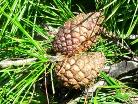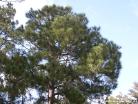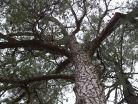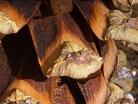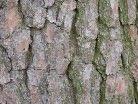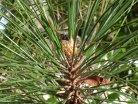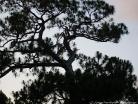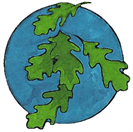
Sources:
Trees of North America- A guide to field identification-a Golden Field Guide from St. Martin's Press © 2002 By C. Frank Brockman p.26
Diseases of Trees and Shrubs, 2nd edition, by Wayne A. Sinclair and Howard H. Lyon, © 2005 Cornell University, Cornell University Press, p. 366
USDA, NRCS. 2011. The PLANTS Database (<http://plants.usda.gov/>, 22 August 2011). National Plant Data Team, Greensboro, NC 27401-4901
Cary, Jennifer H. 1992. Pinus echinata. In: Fire Effects Information System, [Online]. U.S. Department of Agriculture, Forest Service, Rocky Mountain Research Station, Fire Sciences Laboratory (Producer). Available: http://www.fs.fed.us/database/feis/ [2011, August 22].
Trees of North America- A guide to field identification-a Golden Field Guide from St. Martin's Press © 2002 By C. Frank Brockman p.26
Diseases of Trees and Shrubs, 2nd edition, by Wayne A. Sinclair and Howard H. Lyon, © 2005 Cornell University, Cornell University Press, p. 366
USDA, NRCS. 2011. The PLANTS Database (<http://plants.usda.gov/>, 22 August 2011). National Plant Data Team, Greensboro, NC 27401-4901
Cary, Jennifer H. 1992. Pinus echinata. In: Fire Effects Information System, [Online]. U.S. Department of Agriculture, Forest Service, Rocky Mountain Research Station, Fire Sciences Laboratory (Producer). Available: http://www.fs.fed.us/database/feis/ [2011, August 22].
Click here for print friendly version.
Map courtesy USDA NRCS PLANTS Database
Shortleaf Pine,
Pinus echinata Mill.
Pinus echinata Mill.
State List: AL, AR, DE, FL, GA, IL, IN, KY, LA, MD, MO, NC, NJ, NY, OK, OH, PA, SC, TN, TX, VA, WV
Visit the Image Gallery for more photos
Common names: Shortleaf Yellow Pine, Southern Yellow Pine, Yellow Pine, Shortstraw Pine, Arkansas Pine, Old Field Pine
ENDANGERED in Illinois
An evergreen native conifer, Shortleaf pine has the widest distribution of any southeastern pine species. It commonly attains 100 feet in height and 2 to 3 feet in diameter. A straight single trunk supports a narrow, conical to pyramidal or flat topped crown. It has a deep tap root and lateral roots about 24 inches beneath the surface and is wind firm. Pinus echinata's bark is dark brown to almost black when young, but gradually turns reddish brown with age. Some of the outer plates may have a grayish tint. The bark is rough and broken into vertical irregular plates that tend to flake off and reveal the redder bark beneath. Needles are short, hence the name Shortleaf pine, usually
Visit the Image Gallery for more photos
Common names: Shortleaf Yellow Pine, Southern Yellow Pine, Yellow Pine, Shortstraw Pine, Arkansas Pine, Old Field Pine
ENDANGERED in Illinois
An evergreen native conifer, Shortleaf pine has the widest distribution of any southeastern pine species. It commonly attains 100 feet in height and 2 to 3 feet in diameter. A straight single trunk supports a narrow, conical to pyramidal or flat topped crown. It has a deep tap root and lateral roots about 24 inches beneath the surface and is wind firm. Pinus echinata's bark is dark brown to almost black when young, but gradually turns reddish brown with age. Some of the outer plates may have a grayish tint. The bark is rough and broken into vertical irregular plates that tend to flake off and reveal the redder bark beneath. Needles are short, hence the name Shortleaf pine, usually

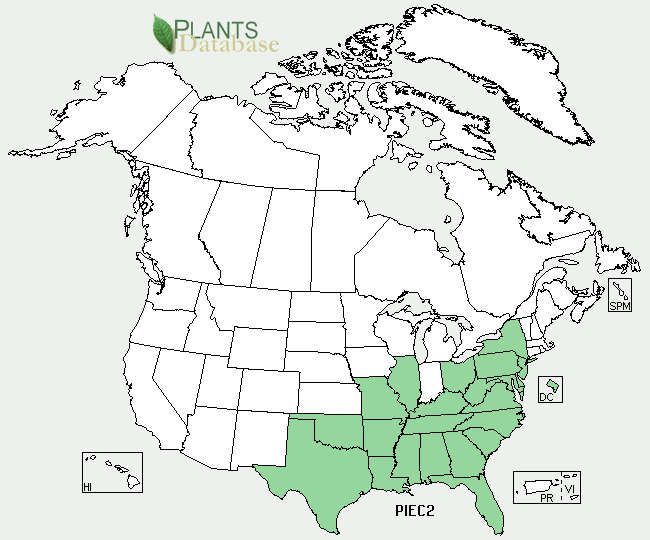
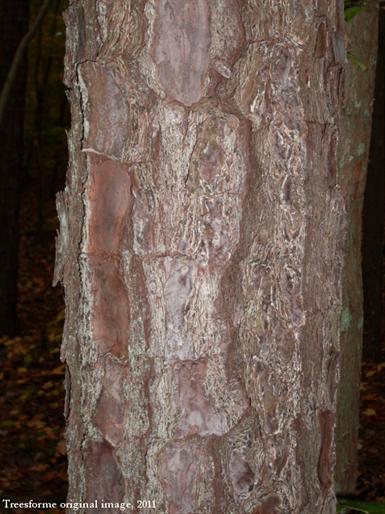
between 3 to 5 inches. They can be bluish-green to yellowish-green, are 2 bundled and persist (remain on tree) up to 4 years. The small, orangish-brown cones are pendulant, meaning they hang from the branches. Ranging in size from 1.5 to 2.5, the female cones have prickle tipped scales and often remain on trees for an extended period of time after seed release. Shortleaf pine is a fast growing tree, reaching 60 feet in only 20 years, and it may live up to 250 years.
Habitat
Found most often on plains or southern and western facing slopes, this native pine species grows best in deep, well-draining, but moist soils with a pH between 4.5 and 6.5. Although adapted to just about any soil texture, preferred sites are sandy or sandy loams with low
Habitat
Found most often on plains or southern and western facing slopes, this native pine species grows best in deep, well-draining, but moist soils with a pH between 4.5 and 6.5. Although adapted to just about any soil texture, preferred sites are sandy or sandy loams with low
organic content. Usually found at elevations ranging from 10 to 3,000 feet, this shade intolerant tree will eventually be replaced and shaded out by more dominant species without recurring fires to clear out competition. Annual rainfall needs are 34 to 65 inches, but it is moderately drought tolerant. It is cold hardy down to -18°F, and also requires 180 frost free days.
Pests, Diseases and Elemental
A newer threat to Shortleaf Pine is what's known as Littleleaf disease. This pathogen mainly affects trees found on old, eroded agricultural crop fields. Soils low in nutrients with poor drainage combined with both water logged and water deficient periods contribute to the risk of infection. Symptoms include chlorotic, stunted foliage, needle loss, and dieback. The underlying cause of decline is due to necrosis of feeder root systems. Unusually large cone crops may indicate distress. Infected Shortleaf pines are typically 30 to 50 years old and only live an average of 6 years after symptoms first appear. Pinus echinata is also susceptible to root rot and red heart rot. Common insect pests include the southern pine beetle, redheaded pine sawfly, Nantucket pinetip moth, black turpentine beetle, loblolly pine sawfly, and pine engraver beetles. Shortleaf pine is sensitive to acid rain and ozone pollution. Both environmental hazards cause stunted growth.
Uses
Shortleaf pine is a major commercial timber tree, second only to Loblolly Pine (Pinus taeda) in the southeastern United States. The strong wood is used in many aspects of construction and furnishings such as veneer, pulpwood, naval applications, and lumber. It is even utilized for Christmas as greenery decoration and Christmas trees. It has also been used to reclaim and rehabilitate mine sites, for erosion control and watershed management. Shortleaf pine can be found in nurseries but its seldomly used in landscaping. Like all pines, the resin contains
Pests, Diseases and Elemental
A newer threat to Shortleaf Pine is what's known as Littleleaf disease. This pathogen mainly affects trees found on old, eroded agricultural crop fields. Soils low in nutrients with poor drainage combined with both water logged and water deficient periods contribute to the risk of infection. Symptoms include chlorotic, stunted foliage, needle loss, and dieback. The underlying cause of decline is due to necrosis of feeder root systems. Unusually large cone crops may indicate distress. Infected Shortleaf pines are typically 30 to 50 years old and only live an average of 6 years after symptoms first appear. Pinus echinata is also susceptible to root rot and red heart rot. Common insect pests include the southern pine beetle, redheaded pine sawfly, Nantucket pinetip moth, black turpentine beetle, loblolly pine sawfly, and pine engraver beetles. Shortleaf pine is sensitive to acid rain and ozone pollution. Both environmental hazards cause stunted growth.
Uses
Shortleaf pine is a major commercial timber tree, second only to Loblolly Pine (Pinus taeda) in the southeastern United States. The strong wood is used in many aspects of construction and furnishings such as veneer, pulpwood, naval applications, and lumber. It is even utilized for Christmas as greenery decoration and Christmas trees. It has also been used to reclaim and rehabilitate mine sites, for erosion control and watershed management. Shortleaf pine can be found in nurseries but its seldomly used in landscaping. Like all pines, the resin contains
turpentine, which can be distilled. Turpentine has been used in times past to treatment of a variety of ailments. Respiratory complaints like coughing, bronchitis, common colds, and influenza were eased by steam baths and inhalers. Skin problems, wounds and sores were also treated with poultices and salves. In the late 1800's, it was even used to treat tuberculosis. Besides commercial value, this tree species is a valuable component of the habitat in which it dwells. A variety of wildlife eat the seeds and browse on the foliage, and it provides shelter and nesting sites for birds and small mammals.
Shortleaf pine bark, Raleigh, North Carolina
©2011, Treesforme original image. See usage requirements.
©2011, Treesforme original image. See usage requirements.

Want to add your tree to our picture gallery? Click here for details!
Tree lists:
•A-Z by scientific
name
•A-Z by common
name
•By Family
For state A-Z list click state name below.
•A-Z by scientific
name
•A-Z by common
name
•By Family
For state A-Z list click state name below.
-Color denotes a tree that is rare or endangered





™
- Trees
- A-Z scientific
- A-Z by Common Name
- Families
- Aceraceae Maple Family
- Anacardiaceae Sumac Family
- Annonaceae Custard Apple Family
- Aquifoliaceae Holly Family
- Arecaceae, Palm Family
- Betulaceae Birch family
- Bignoniaceae Trumpet Creeper Family
- Burseraceae Frankincense Family
- Caprifoliaceae Honeysuckle Family
- Chrysobalanaceae Coco-plum Family
- Cornaceae Dogwood Family
- Cupressaceae Cypress Family
- Cyrillaceae Cyrilla Family
- Ebenaceae Ebony Family
- Ericaceae Heath Family
- Fabaceae Pea Family
- Fagaceae Beech Family
- Hamamelidaceae Witch Hazel Ffamily
- Hippocastanaceae Horse Chestnut Family
- Juglandaceae Walnut Family
- Lauraceae Laurel Family
- Leitneriaceae Corkwood Family
- Magnoliaceae Magnolia Family
- Meliaceae Mahogany Family
- Moraceae Mulberry Family
- Myricaceae Bayberry Family
- Myrsinaceae Myrsine Family
- Myrtaceae Myrtle Family
- Nyctaginaceae Four Oclock Family
- Olacaceae Olax Family
- Oleaceae Olive Family
- Pinaceae Pine Family
- Platanaceae Plane Tree Family
- Polygonaceae Buckwheat Family
- Rhamnaceae Buckthorn Family
- Rosaceae Rose Family
- Rubiaceae Madder Family
- Rutaceae Rue Family
- Salicaceae Willow Family
- Sapindaceae Soapberry Family
- Sapotaceae Sapodilla Family
- Simaroubaceae Quassia Family
- Styracaceae Storax Family
- Symplocaceae Sweetleaf Family
- Theaceae Tea Family
- Tiliaceae Lindon Family
- Ulmaceae Elm Family
- Taxaceae Yew Family
- Yucca Family
- Browse by State
- Rare or Endangered Species
- Trees_with_Special_Uses
- Tallest and Biggest
- Noxious Weeds
- Causes
- About Us
- Our Stores

Custom Search
